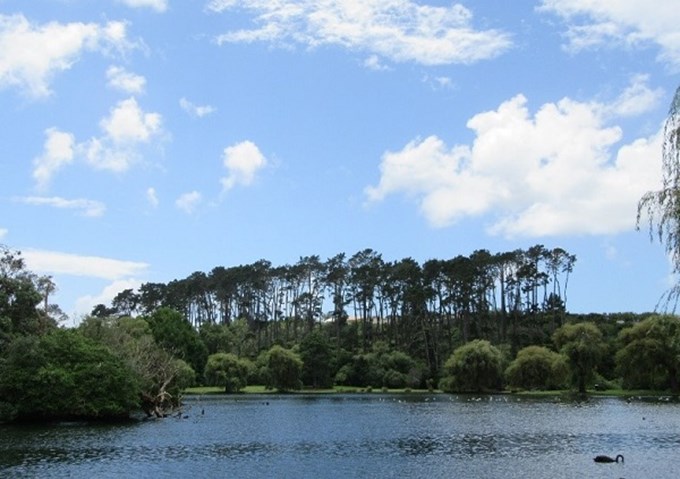Latest update - 16 October 2019
The appeal against the resource consent decision has been settled and, subject to further planning, the pine trees will be removed in March/April 2020.
Felling work is expected to take around three to four weeks, with the full project taking around two months. This time frame avoids bird nesting season. New tree planting will start immediately after the pine trees are felled.
Check out the council’s website for more information.
Latest update – 19 August 2019
The track through the trees in Western Springs was closed in April 2018 following a number of tree failures. It remains closed due to concerns for the safety of path users as there is a high risk of trees toppling or snapping and falling onto the path. Under the Health and Safety at Work Act 2015 we had an obligation to close the track to protect the public.
The resource consent to fell the trees was granted in May 2019. The commissioners accepted that removing the trees is necessary due to ongoing and increasing safety concerns.
The resource consent decision is currently being appealed. The tracks will remain closed until we know the outcome. The timeframe for the appeal process is unknown at this point.
Subject to the appeal, the next window to remove the trees is March/April 2020 to avoid bird nesting season.
Once underway, we estimate that the project will take up to two months, with actual felling work taking about one and a half months. The area, including the tracks, will be closed to the public until after the trees are removed.
Click here for more information.
Original story
A native forest is planned for Western Springs Lakeside Reserve.
The native bush restoration project envisages a functioning podocarp-broadleaf forest planted with kauri, pūriri, taraire and tānekaha.
Before the native forest can be planted, a stand of about 200 pines will have to be removed.
The pines are past their life expectancy and are declining rapidly, despite regular maintenance. They now pose a risk to public safety because of their size and age.
There were originally 506 pines in the stand, but a 2013 survey found 224 had died or fallen, reducing the stand to 282. A 2016 survey found the live population had declined to about 200 after around 60 fell or snapped, and 20 unstable pines were felled.
Many of the remaining pine trees lean within falling distance of the walking track and are in poor health, with sparse crowns and dead or dying limbs. However, removing only those trees would dramatically increase the failure rate among any left behind.
Returning the area to native forest
After consultation during the 2015-2025 Long-term Plan, the Board approved the Western Springs Native Bush Restoration Project. Its objectives were addressing health and safety concerns posed by the pines and fulfilling the vision of the Western Springs Lakeside Management Plan to return the area to native forest.
The planting and track plans will be developed with the local community. Residents in the immediate vicinity have been informed, and a publicly notified consent application is being prepared.
Board deputy chair and parks, sports and recreation portfolio lead Shale Chambers says the complexity of the project led to the plan being delayed as all options were reviewed.
“No one wants trees removed unnecessarily,” he says.
“But a visit to Auckland Zoo, where pines made way for Te Wao Nui native precinct, shows the potential to create a special urban native bush experience in Western Springs.”
The pines will be felled into selected zones, determined by ecologists, to limit damage to undergrowth. About 70 per cent of the wood will be removed or mulched, and the rest, mainly trunks, will be left as a habitat for native fauna. About 20 totem poles will remain for kingfisher and morepork, and logs will be left as a habitat for the insects they eat.
“Complete removal will enable us to keep the area safe and to start a restoration programme. There’s also the chance to expand the track network,” Chambers says.

It’s estimated the planting and restoration effort will use about 15,000 plants and see improved paths in the area.
Subject to consent, the project will take about three months, with felling about for two of those months, and working hours restricted from Monday to Friday, 7am-5pm.
The removal methodology has been reviewed and verified by an independent party and while the pine trees are being removed, the forested area, including the tracks will be cordoned off.
The public will be able to raise any concerns they have as the resource consent application will be notified. The regeneration and track plans will be confirmed with community input.
There are exotic and native birds in the pines but the board has had expert advice that the area is not an important white-faced heron habitat, and that none were recorded in a 2016 survey. Despite that, no felling will take place in their June to October nesting season – unless in an emergency.
The site will also undergo inspection by ecologists before the project starts.
Read the letter sent to residents
Western Springs Pine Stand Restoration and Accessibility Plan
Western Springs Pine Tree Removal Project Methodology
Ask something else: westernsprings@aucklandcouncil.govt.nz


